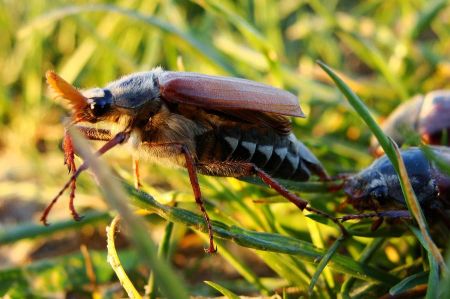Lights out for the May beetle or Cockchafer
- Written by Portal Editor
Everyone knows them, at least the chocolate version, but very few people have ever seen a live May beetle up close.
This year, the chances are good: the fat buzzing creatures with the white zigzag lines on their sides are currently crawling out of the ground in particularly large numbers.
2025 is a May beetle year – but bright gardens disrupt mating
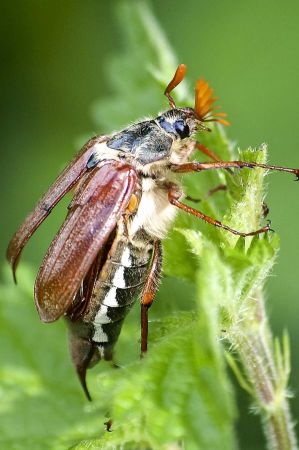 The dry spring gave the larvae – also called grubs – very good starting conditions in many places. Such May beetle years occur every three to five years – that's how long it takes the insects to develop in the soil from egg to pupa to adult beetle.
The dry spring gave the larvae – also called grubs – very good starting conditions in many places. Such May beetle years occur every three to five years – that's how long it takes the insects to develop in the soil from egg to pupa to adult beetle.
May beetles have only four to seven weeks to survive. As soon as they crawl out of the ground, the males go in search of a female. Immediately after mating, the males die, and the females lay their eggs in the soil – then they too perish.
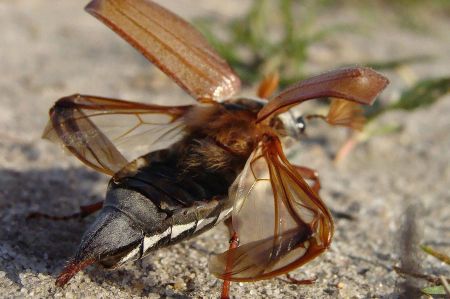 "Until then, the cockchafers fly with a loud buzzing through green spaces, natural gardens, and forests in search of females and food; they feast on the leaves of deciduous trees," says Jennifer Calvi of the German Wildlife Foundation.
"Until then, the cockchafers fly with a loud buzzing through green spaces, natural gardens, and forests in search of females and food; they feast on the leaves of deciduous trees," says Jennifer Calvi of the German Wildlife Foundation.
"However, light pollution often proves their undoing." Like many other insects, the beetles fly purposefully toward light sources, a behaviour known as positive phototaxis.
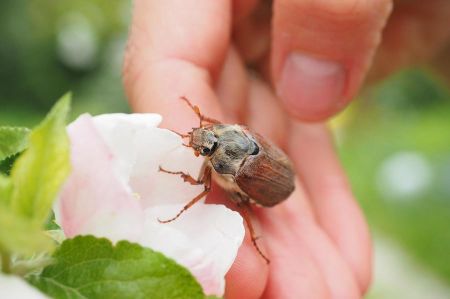 In nature, cockchafers orient themselves using moonlight. Artificial light sources are usually much brighter and closer – and instead of flying in a straight line, the cockchafers or May beetle often circle the light source in a spiral until they are exhausted. "These errant flights disorient them and prevent them from reproducing," says Calvi. "If you choose insect-friendly lamps in your garden, on your terrace, or balcony, you protect the beetles." Although cockchafers are currently considered safe, according to the Red List Centre, there has been a significant decline compared to populations 50 to 100 years ago.
In nature, cockchafers orient themselves using moonlight. Artificial light sources are usually much brighter and closer – and instead of flying in a straight line, the cockchafers or May beetle often circle the light source in a spiral until they are exhausted. "These errant flights disorient them and prevent them from reproducing," says Calvi. "If you choose insect-friendly lamps in your garden, on your terrace, or balcony, you protect the beetles." Although cockchafers are currently considered safe, according to the Red List Centre, there has been a significant decline compared to populations 50 to 100 years ago.
Three tips for insect-friendly lighting:
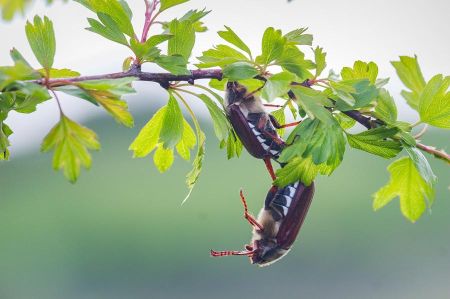 1. Shield the light source, as targeted light directed downwards reduces light scattering. 2. Blue light components in lighting fixtures are particularly harmful to many insects. So don't use bright LED, halogen, or fluorescent tubes, but rather warm white bulbs with less than 3000 Kelvin. 3. Timers and motion detectors reduce the burning time and thus light pollution.
1. Shield the light source, as targeted light directed downwards reduces light scattering. 2. Blue light components in lighting fixtures are particularly harmful to many insects. So don't use bright LED, halogen, or fluorescent tubes, but rather warm white bulbs with less than 3000 Kelvin. 3. Timers and motion detectors reduce the burning time and thus light pollution.
Visitors can learn what everyone can do for May beetle, insects and other wild animals in their garden at the Embassy of Wild Animals, the permanent exhibition of the German Wildlife Foundation in Hamburg's HafenCity.
Jennifer Calvi
Press Officer
German Wildlife Foundation
Lucy-Borchardt-Straße 2
20457 Hamburg
Phone +49 40 9707869-14
This email address is being protected from spambots. You need JavaScript enabled to view it.
www.DeutscheWildtierStiftung.de
Please read as well:
